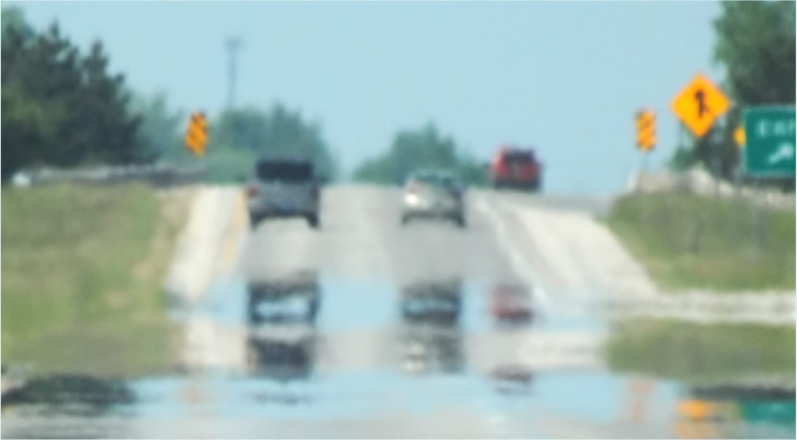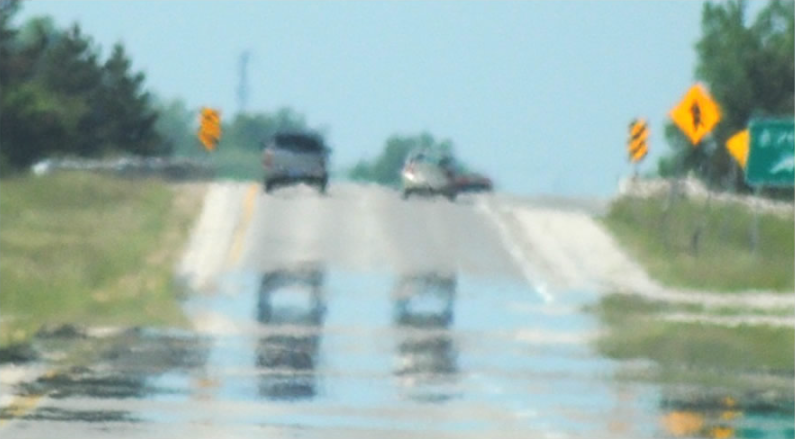OPOD - Peculiar Mirage
OPOD - Peculiar Mirage: Exploring the Unusual Phenomenon of Multiple Car Images
Mirages have long fascinated us with their optical illusions and surreal imagery. We are accustomed to seeing inverted images in mirages, where objects appear to be reflected in pools of water on hot roads. However, there are instances when mirages exhibit peculiar characteristics that defy our expectations. One such example is the presence of multiple car images, some of which are even upright. In this article, we delve into the intriguing world of peculiar mirages and explore how topology theory helps us understand their formation.
Unraveling the Mystery of Peculiar Mirages
The photographs captured by Adam Kraft provide a glimpse into this fascinating phenomenon. As the temperature soared to 86 degrees, Kraft was able to document mirages during his journey as a passenger. The particular stretch of road he encountered was known for its remarkable mirages, prompting him to keep his camera at the ready. This road, characterized by its hilly and valley terrain, played a significant role in creating the unique mirages Kraft witnessed.
The Role of Temperature Gradients and Road Topology
Typically, hot road mirages, known as "inferior mirages," occur when light rays are refracted by temperature gradients between the warm air near the heated road surface and the cooler air above. These mirages often result in inverted images of objects. However, what sets peculiar mirages apart is the presence of multiple images of each car, some of which defy the norm by appearing upright.
The undulating nature of the road contributes to this phenomenon by tilting the layers of air with different temperatures. This tilt introduces variations in the refractive index, causing light rays to follow different paths and resulting in the formation of multiple car images. While we are accustomed to observing a single inverted object in road mirages, the extent and favorable temperature gradients in peculiar mirages allow for a broader range of image orientations.
Unlocking the Secrets with Topology Theory
Rather than delving into the intricate details of temperature conditions and ray paths required to produce these peculiar mirages, we can turn to mathematical topology theory for valuable insights. Topology theory provides us with a simpler way to understand the form these mirages take.
According to topology theory, a complete mirage must have an odd number of images, including the "real" image of the object itself. The sum of erect images minus the inverted ones must equal one. This constraint significantly restricts the possible image orientations. For instance, three erect images are deemed impossible under this theory. In most cases, images alternate between erect and inverted positions, adhering to the rule that a mirage should be capable of being easily deformed into the real object through folding or pleating.
The Richness of Real-Life Mirages
While topology theory offers valuable insights into peculiar mirages, it is essential to acknowledge that real-life mirages are often more complex and diverse. Inferior mirages rarely manifest as complete images, and some may be so distorted or compressed that they go unnoticed. Nevertheless, topology theory provides a useful framework for identifying and understanding the key characteristics to look for in mirages.
In conclusion, peculiar mirages captivate us with their unusual qualities, such as the presence of multiple car images, including upright ones. The interplay between temperature gradients, road topology, and light refraction gives rise to these mesmerizing optical illusions. By applying topology theory, we gain a deeper understanding of the underlying principles governing the formation of peculiar mirages. So, keep your eyes peeled during your next road trip, as you never know when you might encounter one of these extraordinary atmospheric phenomena.
Note: This article has been automatically converted from the old site and may not appear as intended.

Peculiar Mirages & How Topology Helps
Miraged cars in telephoto (300mm) shots by Adam Kraft.
"Today it was 86 degrees and as a passenger I was able to photograph mirages as we traveled along. This particular part of the road is always great for them and I always have my camera ready when we get near it. The highway has a lot hills and valley's and this is in one of the small valleys."
©Adam Kraft, shown with permission.

What is unusual about this mirage is the car images. Some are upright!
We are so used to seeing inverted images in mirages over hot roads where cars and other objects are seemingly reflected in pools of water. But here there are multiple images of each car some impossible upright, some inverted.
The undulating road is partly responsible by tilting the layers of different temperature air. Hot road mirages, ‘inferior mirages, are produced by light rays refracted by the temperature gradients between warm air close to the hot solar heated road surface and cooler air above.
While we are used to seeing a single inverted object in road mirages there is no reason why they should be so limited if the mirages is extensive enough and if favourable temperature gradients exist.

We could agonise over the precise temperature conditions and ray paths necessary to produce these multiple car mirages. But it is not necessary because mathematical topology theory tells us more easily the form that they have to take.
A complete mirage must have an odd number of images if we include the ‘real’ image of the object itself.
The sum of erect images minus the inverted ones must be one. This severely restricts image orientation, for example three erect images are impossible.
Usually images alternate as erect, inverted, erect A consequence of the rule that a mirage must be capable of being simply deformed by folding or pleating into the real object.
Real life is inevitably richer! Inferior mirages are rarely complete and some images might be so squashed that they are not seen. Nonetheless, topology theory gives a good guide for what to look for in mirages.
Note: this article has been automatically converted from the old site and may not appear as intended. You can find the original article here.
Reference Atmospheric Optics
If you use any of the definitions, information, or data presented on Atmospheric Optics, please copy the link or reference below to properly credit us as the reference source. Thank you!
-
<a href="https://atoptics.co.uk/blog/opod-peculiar-mirage/">OPOD - Peculiar Mirage</a>
-
"OPOD - Peculiar Mirage". Atmospheric Optics. Accessed on November 26, 2024. https://atoptics.co.uk/blog/opod-peculiar-mirage/.
-
"OPOD - Peculiar Mirage". Atmospheric Optics, https://atoptics.co.uk/blog/opod-peculiar-mirage/. Accessed 26 November, 2024
-
OPOD - Peculiar Mirage. Atmospheric Optics. Retrieved from https://atoptics.co.uk/blog/opod-peculiar-mirage/.